Adventure Divas (34 page)

“You’re not going to use this footage just to play into people’s fears and stereotypes, are you?” says Persheng, having noted our “scary” collection of b-roll. I think she’s worked with Western crews in the past who wanted a flavorful, but not necessarily real, story. She wants me to know that Iran is not all terrorists and veils.
“No, no,” I say. “I understand that it’s just government manipulation. Don’t worry. But the show has to acknowledge those fears and misperceptions in order to move beyond them, right?” I explain.
Despite the glowering religious icons looming above, the country does not
feel
scary, and we’ve yet to experience any anti-American sentiment from a three-dimensional human. On the contrary, we’ve been greeted with warmth everywhere we’ve gone. Earlier we were chasing down a rumor of a wall said to be covered with anti-U.S. slogans. We arrived at the location and asked the old security guard about it. “Oh, I painted over that years ago,” he said with a dismissive laugh and a sweep of his hand. “Please, please sit and have some tea with me, and perhaps a pipe?” he said, nodding toward a hookah.
The story of Iran’s Islamicist revolution, and especially its impact on women, is not simple. In the 1970s, before the revolution, Iran was run by Mohammad Reza Pahlavi, who succeeded his father as shah in 1941, and Tehran was experiencing rock music, reefer, and miniskirts along with much of the world. Wearing
hejab
was actively discouraged by the government. But while a wealthy minority lived the high life, the masses lived in poor conditions with high illiteracy and little health care. Like Batista in Cuba, the shah was an autocrat installed and propped up by the United States (read: CIA), and he stirred up a great deal of popular resentment. Workers and middle-class students protested against widespread offical corruption and the lack of jobs. Religious conservatives railed against “Westoxification” of their country. Some women, both religious and secular, who wanted the regime
out,
took to wearing veils as an act of political defiance.
Many political factions participated in the resistance to the shah—not only Islamists, but leftists, communists, and feminists as well. But as the anti-shah forces gained strength, it was the more conservative elements of the opposition that came to the fore.
In January 1979, the shah was forced out of the country as the result of a massive popular uprising. Two weeks later, Ayatollah Khomeini returned from exile in France and joined with secularist anti-shah forces in the formation of a new government. Over the next few years, faced with a hostile United States and a bloody war with neighboring Iraq, Khomeini and the theocrats consolidated their power. As Maryam is fond of saying, “The deal was done.” A band of conservative religious clerics slipped into the void of what was essentially and originally a
political—
not religious—revolution.
For Iranian women, the revolution has been a mixed bag. A “jihad against illiteracy” and greater access to education have created opportunities that were previously unavailable to most Iranian women. Sixty percent of Iran’s university students are women now, compared with 25 percent before the revolution. But Khomeini also put in place a system of draconian family laws and strict dress codes for women. Veiling was no longer optional but mandatory.
In the twenty-five years since conservative theocrats took power, there has been a slow, staccato walk toward political reform. Women have successfully protested for more freedoms and for the relaxing of some veiling requirements. On May 23, 1997, the reformist religious cleric Mohammad Khatami was democratically voted into office as president. But, since the religious supreme leader trumps the elected president in the Islamic Republic, Khatami was less able to bring reform than a now frustrated populace had hoped. Some blame Khatami for the slow change; others think his hands were tied by the reigning theocratic powers. He was reelected in 2001, but faith in Khatami continued to plunge. (And in July 2005 ultraconservative Mahmoud Ahmadinejad was elected president.)
Nonetheless, Khatami’s election in 1997 ushered in an era of relative freedom for the Iranian press. At any given time, there are about fifty nongovernmental publications on the street in Tehran. But publishing remains risky business. Recently there has been another of several waves of crackdowns by the conservatives; scores of publications have been shuttered, and many of their publishers are under indictment.
While my first-amendment instincts cry out at this censorship, I know that my own culture also has forces that get in the way of a free and robust press. Here in Iran it is the government that impedes; in the United States, it’s profit-driven media conglomerates. In the United States, news judgments are frequently not based on what people need to know, but what they are perceived (through polls or ratings) to enjoy consuming. Thus, a market fundamentalism—a tyranny of profit—determines what is news. As Neil Postman says in his now twenty-year-old (yet still prescient) critique of television,
Amusing Ourselves to Death,
“Censorship, after all, is the tribute tyrants pay to the assumption that a public knows the difference between serious discourse and entertainment—and cares.”
The role of the press in Iran’s reform movement is critical to understand, so I want to meet Shahla Sherkat, one of Iran’s best-known publishers. Last year she was sentenced to four months in prison and a three-thousand-dollar fine—a significant amount of money in Iran, undoubtedly more than a year’s salary for her—for attending a conference of international journalists and arguing in a public setting that
hejab
should be a matter of
choice,
rather than law. Sherkat remains hard at work while her case is on appeal.
Sherkat’s magazine
Zanan
has a circulation of more than 100,000 and rides a dangerous wave of feminism and politics. For more than a century, through shahs and clerics alike, Iranian women have struggled for more liberty.
Zanan
marks a contemporary chapter in that struggle and the magazine is credited with turning out the critical women’s vote for President Khatami, the only candidate who called for greater freedom for women and for the government to move to a less strict interpretation of sharia, or Islamic law.
We walk up to the second floor of an unremarkable gray cement building in midtown Tehran and into the
Zanan
offices, which are filled with a dozen young women in conservative black and gray
hejab.
Early-nineties PCs hum with activity and stacks of magazines accent the waiting area. I am struck by the spendy graphic sophistication of the covers, and by how politically frank they are. One of them has been enlarged and hung behind Sherkat’s desk: a red and black image of a woman pulling the veil back to reveal her lipsticked mouth. Sherkat greets us with a reserved smile and a Western handshake. Forty-something Sherkat, who has dark, intense eyes, is dressed conservatively in a tan gown with a full black head scarf. We set up to interview her at her desk, behind which are shelves bulging with feminist books from publishers around the world.
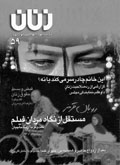
“Does This Woman Wear a Chador?”
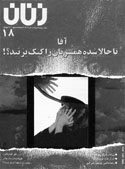
“Sir, Have You Ever Hit Your Wife?”
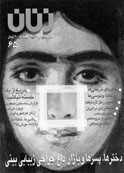
“Girls, Boys, and the Popularity of Nose Jobs”
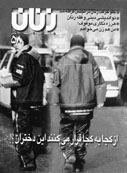
“Where Are These Girls Running To?”
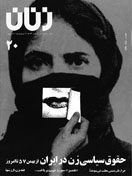
“The Political Rights of Women in Iran”
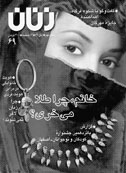
“Women, Why Do You Buy Gold?”
Once a revolutionary student who hit the streets to bring down the shah, Sherkat now regards herself as a reformist journalist. By way of introduction to the magazine, she takes me through past issues.
“This issue features an interview with Mrs. Khatami. It was published especially for the elections,” she says, holding up a cover with a smiling first lady. While Sherkat and her magazine have supported Mrs. Khatami’s husband, they turned critical of him when, after elected, he appointed only one woman to his cabinet.
